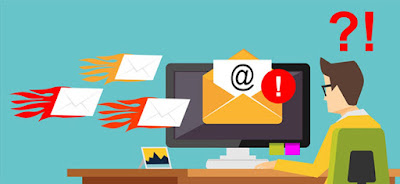WHAT IS EMAIL BOMBARDMENT?
An email bombing is an attack on your inbox that involves sending massive amounts of messages to it. Sometimes these messages are incomprehensible. But more often, they will be confirmation emails for newsletters and subscriptions.

The term Email Bombing or Email Bombing; it can also refer
to flooding an email server with too many emails. In an attempt to overwhelm
the server and disable it. But that's not the goal here; it would be a
challenge to cut down on the modern email accounts used.
Meanwhile, Google or Microsoft email servers, anyway. So
instead of a denial of service (DOS) attack; against the email servers you are
using. Also, the flood of messages is a distraction to hide the true intentions
of the attacker.
Why Is This Happening To You?
Thus, an email blitz is often a distraction used to bury an
important email in your inbox and hide it. For example, an attacker may have
gained access to one of your accounts on an online shopping website like
Amazon. And likewise, having ordered expensive products for himself.
Similarly, email bombardment floods your inbox with totally
irrelevant messages, burying purchase and shipping confirmation emails so you
don't notice them.
Indeed, if you own a domain, the attacker may be trying to transfer
it. If an attacker gained access to your bank account or other financial
service account. You could also be trying to hide confirmation emails for
financial transactions.
Email bombardment can take control of your email
Similarly, by flooding your inbox, the email bombardment
serves as a distraction from the real damage. Burying a relevant email about
mountains and mountains of junk mail. Also, when they stop sending you wave
after wave of emails; it may be too late to undo the damage.
You can also use this "technique" to gain control
of your email address. Similarly, if you have a coveted address, something
simple with few symbols and a real name. For example, some things can frustrate
you to the point that you abandon that email address. Now the attacker can take
that address and use it for his own purposes.
What
to Do When You Receive an Email Bombardment?
If you are a victim of this, the first thing to do is
verify and block your accounts. You must log into any purchasing account; like
Amazon and check your recent orders. If you see an order that you didn't place,
you should contact the customer service of the shopping website as quickly as
possible.
Also, you may want to take this one step further. On
Amazon, it is possible to "archive" orders and hide them from your
normal order list. Similarly, a Reddit user discovered an email from Amazon
confirming an order for five graphics cards with a total value of $ 1,000.
This email was buried in a flood of incoming emails.
Likewise, when he went to cancel the order, they couldn't find it. The attacker
had archived the Amazon order, hoping that would help him slip under the radar.
Similarly, you can check Amazon's archived orders on your
account page on the platform. Now, you must click on "Archived orders",
you can find it in "Orders and purchases preferences".
While reviewing your purchasing accounts, it would be wise
to eliminate your payment options entirely. Thus, if the perpetrator is still
waiting to enter your account or order something, they will not be able to do
so.
You
should review the security of your financial accounts
Now, after you've checked any site where you've provided
payment information, you should double-check: bank accounts, credit cards, and
any unusual activity on them. In the same way, you should contact these
financial institutions and inform them of the situation.
They may also be able to block your account and help you
find any unusual activity. If you are the owner of a domain, you must contact
your provider. In turn, you should request help to block the domain so that it
cannot be transferred.
Now, if you discover that an attacker has gained access to
one of your websites, you must change your password on that site. You must make
sure to use strong and unique passwords for all your important passwords. You
should also use an updated antivirus
software in your system that can track if anything wrong happens in your
device or system.
Similarly, a password manager will help. If you can manage
it, you should set up two-factor authentication for each site that offers it.
This will ensure that attackers cannot access an account, even if they somehow
obtain the password for that account.
Time
to face your email
Now that you've secured all of your accounts, it's time to
deal with your email. So, for most email providers, the first step is to
contact your email provider. Unfortunately, contacting Google directly is
extremely difficult, at incredible levels.
Also, Google's contact page doesn't seem to offer a contact
method for most Google users. So if you are a paid Google One subscriber or G
Suite subscriber, you can contact Google support directly.



Antivirus Software
ReplyDeleteAntivirus Software
Antivirus Software
Antivirus Software
Antivirus Software
Antivirus Software
Antivirus Software
Antivirus Software
Antivirus Software
Antivirus Software
Antivirus Software
Antivirus Software
Antivirus Software
Antivirus Software
Antivirus Software
Antivirus Software
Antivirus Software
Antivirus Software
Antivirus Software
Antivirus Software
Antivirus Software
Antivirus Software
Antivirus Software
Antivirus Software
ReplyDeleteAntivirus Software
Antivirus Software
Antivirus Software
Antivirus Software
Antivirus Software
Antivirus Software
Antivirus Software
Antivirus Software
Antivirus Software
Antivirus Software
Antivirus Software
Antivirus Software
Antivirus Software
Antivirus Software
Antivirus Software
Antivirus Software
Antivirus Software
Antivirus Software
Antivirus Software
Antivirus Software
Antivirus Software
Antivirus Software
Antivirus Software
Antivirus Software
Antivirus Software
Antivirus Software
Antivirus Software
Antivirus Software
Antivirus Software
Antivirus Software
Antivirus Software
Antivirus Software
Antivirus Software
Antivirus Software
Antivirus Software
Antivirus Software